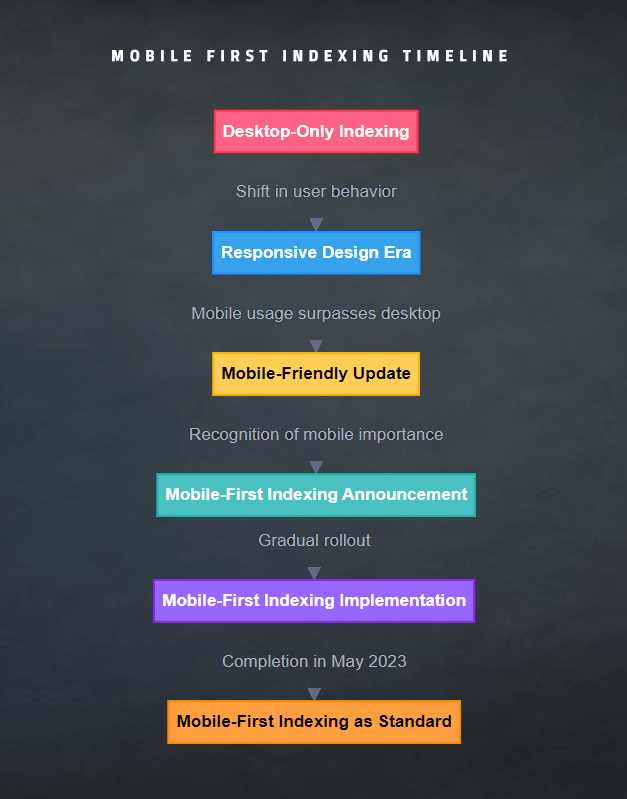
Understanding the Mobile-First Indexing Revolution
Contents
- 1 Understanding the Mobile-First Indexing Revolution
- 2 What is Mobile-First Indexing?
- 3 The Rise of Mobile Web Usage: A Catalyst for Change
- 4 Mobile-First Indexing Best Practices for SEO
- 5 Challenges in Mobile-First Indexing
- 6 How to Implement Mobile-First Indexing
- 7 The Future of Mobile-First Indexing
- 8 Call to Action
Mobile-first indexing is a change in Google’s approach to crawling, indexing, and ranking websites by prioritizing the mobile version of websites over the desktop version. The concept has thus become a cornerstone of effective search engine optimization (SEO) strategies.
The shift in this Google indexing approach has fundamentally changed how businesses and website owners need to think about their online presence. In this comprehensive guide, we’ll explore the ins and outs of Mobile-First Indexing, its impact on SEO, and how you can optimize your website for this new era of search.
What is Mobile-First Indexing?
Mobile-First Indexing is Google’s approach to primarily using the mobile version of a website’s content for indexing and ranking. This marks a significant departure from the traditional method, where the desktop version of a site was the primary source for determining search rankings.
Key Elements of Mobile-First Indexing
| Element | Description |
|---|---|
| Mobile optimization | Google now uses the mobile version of your website as the starting point for what gets indexed. |
| Page speed | Enhancing load times on mobile devices to improve user experience and SEO rankings. Mobile site speed and performance are more important than ever. |
| Responsive design | Creating adaptable layouts that work seamlessly across various screen sizes. This ensures websites are fully responsive and perform well on mobile devices. |
| Content consistency | The content on your mobile site should be equivalent to that on your desktop site, ie ensuring the mobile version has the same content as the desktop version to avoid ranking issues. |
| User experience focus | The mobile user experience is now a critical factor in determining search rankings. |
The Rise of Mobile Web Usage: A Catalyst for Change
Before we dive deep into this topic, let’s take a look at the driving force behind this shift i.e. the explosive growth of mobile web usage.
As illustrated in the chart above, mobile devices now account for over 60% of all web searches. This seismic shift in user behavior has forced search engines, particularly Google, to adapt their indexing methods to better align with how people access and consume online content.
The Evolution of Google’s Indexing Approach
To better understand the significance of Mobile-First Indexing, let’s look at how Google’s indexing approach has evolved over time:

This flowchart illustrates the journey from desktop-centric indexing to the current Mobile-First Indexing standard. Each step represents a significant shift in Google’s approach, driven by changes in user behavior and technological advancements.
Mobile-First Indexing Best Practices for SEO
Implementing a Mobile-first strategy can significantly influence a website’s performance and user engagement positively. Thus, websites that are not optimized for mobile may see a drop in rankings and traffic. The transition to Mobile-First Indexing has had far-reaching implications for SEO practitioners and website owners. Let’s explore some of the key areas affected.
1. Website Design and Development
With Mobile-First Indexing, responsive design is no longer just a best practice—it’s a necessity. Websites must be built with a mobile-first approach, ensuring that the mobile version provides an optimal user experience.
Mobile-First Design Checklist:
- [ ] Responsive layout that adapts to different screen sizes
- [ ] Touch-friendly navigation and buttons
- [ ] Legible font sizes without the need for zooming
- [ ] Properly spaced clickable elements to avoid “fat finger” errors
- [ ] Fast-loading pages optimized for mobile networks
2. Content Strategy
Mobile-First Indexing necessitates a reevaluation of content strategy. The constraints of mobile devices require a more focused approach to content creation and presentation.
Content Considerations for Mobile-First Indexing:
- Prioritize important information at the top of the page
- Use concise, scannable paragraphs
- Implement expandable sections for lengthy content
- Optimize images and videos for mobile viewing
- Ensure all content is accessible on mobile devices
3. Page Speed and Performance
Page Speed and Performance Page speed has always been a crucial factor in SEO, but Mobile-First Indexing has amplified its importance, particularly for mobile pages. Faster loading times improve user experience and SEO rankings. Use tools like Google PageSpeed Insights to identify areas of improvement.
Faster-loading pages not only provide a better user experience but also contribute to improved search rankings.
Improve Mobile Usability Make sure your website is easy to navigate on mobile devices. This includes having readable text without zooming, appropriately spaced links, and touch-friendly navigation.
Ultimately, a responsive design ensures that your website adapts to various screen sizes, providing a seamless experience across all devices. This is essential in a Mobile-first SEO strategy.
4. Technical SEO Considerations
First Indexing has introduced new technical SEO challenges that webmasters must address:
| Technical Aspect | Mobile-First Indexing Implication |
|---|---|
| URL Structure | Separate mobile URLs must be configured correctly with canonical tags |
| Structured Data | Should be present on both mobile and desktop versions |
| XML Sitemaps | Must include mobile URLs if using separate mobile sites |
| Robots.txt | Ensure Googlebot can access and render mobile page content |
| Hreflang | Language annotations should be consistent across mobile and desktop |
Challenges in Mobile-First Indexing
While there are many benefits, implementing Mobile-first indexing also comes with challenges.
Challenges
- Content mismatch between mobile and desktop versions
- Slower page speed on mobile
- Responsive design issues
- Navigation difficulties on smaller screens
Solutions
- Ensure consistent content across all versions
- Optimize images and reduce server response times
- Test responsive design on various devices
- Implement touch-friendly navigation
How to Implement Mobile-First Indexing
To ensure your website is fully optimized for Mobile-First Indexing, follow these essential steps:

Step-by-Step Guide
- Audit Your Website: You can use tools like Google Search Console to identify issues affecting your mobile site.
- Verify Mobile Indexing Status: Use Google Search Console to check if your site has been moved to mobile-first indexing.
- Optimize for Mobile: Ensure your website is fully responsive and loads quickly on mobile devices. Use a responsive design that adapts seamlessly to all screen sizes.
- Monitor Performance: Regularly check your website’s performance metrics to ensure it meets Google’s standards.
- Test Mobile Usability: Use Google’s Mobile-Friendly Test to ensure your site is easy to navigate on mobile devices.
- Stay Updated: Keep up with the latest Google algorithm updates to ensure your site remains optimized.
- Improve Page Speed: Compress images, leverage browser caching, and minimize code to enhance mobile page speed. As mentioned earlier, use PageSpeed Insights to identify areas for improvement.
- Monitor Performance: Regularly analyze your mobile search performance and make data-driven optimizations.
The Future of Mobile-First Indexing
As we look ahead, it’s clear that Mobile-First Indexing is not just a temporary trend but a fundamental shift in how search engines interact with and evaluate websites. Here are some predictions for the future of Mobile-First Indexing:
- Increased Focus on Mobile UX: User experience signals from mobile devices will likely play an even larger role in ranking algorithms.
- Voice Search Optimization: With the rise of mobile voice searches, optimizing for natural language queries will become crucial.
- Progressive Web Apps (PWAs): As PWAs gain popularity, they may receive preferential treatment in mobile search results.
- 5G Impact: The rollout of 5G networks will raise user expectations for mobile page speed and performance.
- AI and Mobile Search: Advanced AI algorithms will further refine mobile search results based on user context and intent.
Ultimately, as mobile internet usage continues to grow, Mobile-first indexing will become even more critical. Future trends may include more advanced mobile optimization techniques and further emphasis on user experience.
Call to Action
Mobile-First Indexing represents a paradigm shift in the world of SEO and web development. By prioritizing the mobile user experience, creating mobile-optimized content, and focusing on mobile performance, website owners can not only improve their search rankings but also provide a better experience for the majority of their users.

Remember, this ranking concept is not just about satisfying search engines—it’s about meeting the needs and expectations of your mobile users. Thus, by embracing this approach, you’re not only improving your SEO but also enhancing the overall user experience for the majority of your audience.
Stay ahead in the digital world by optimizing your site for Mobile-first indexing. You can contact our SEO experts today to ensure your website is mobile-friendly and ready to rank higher on Google.

